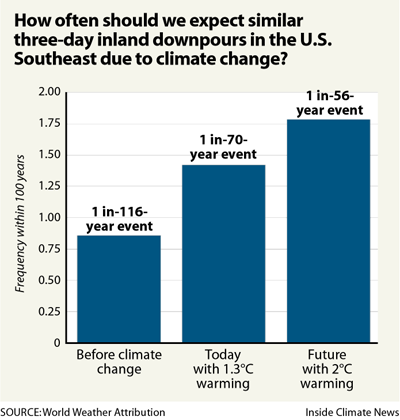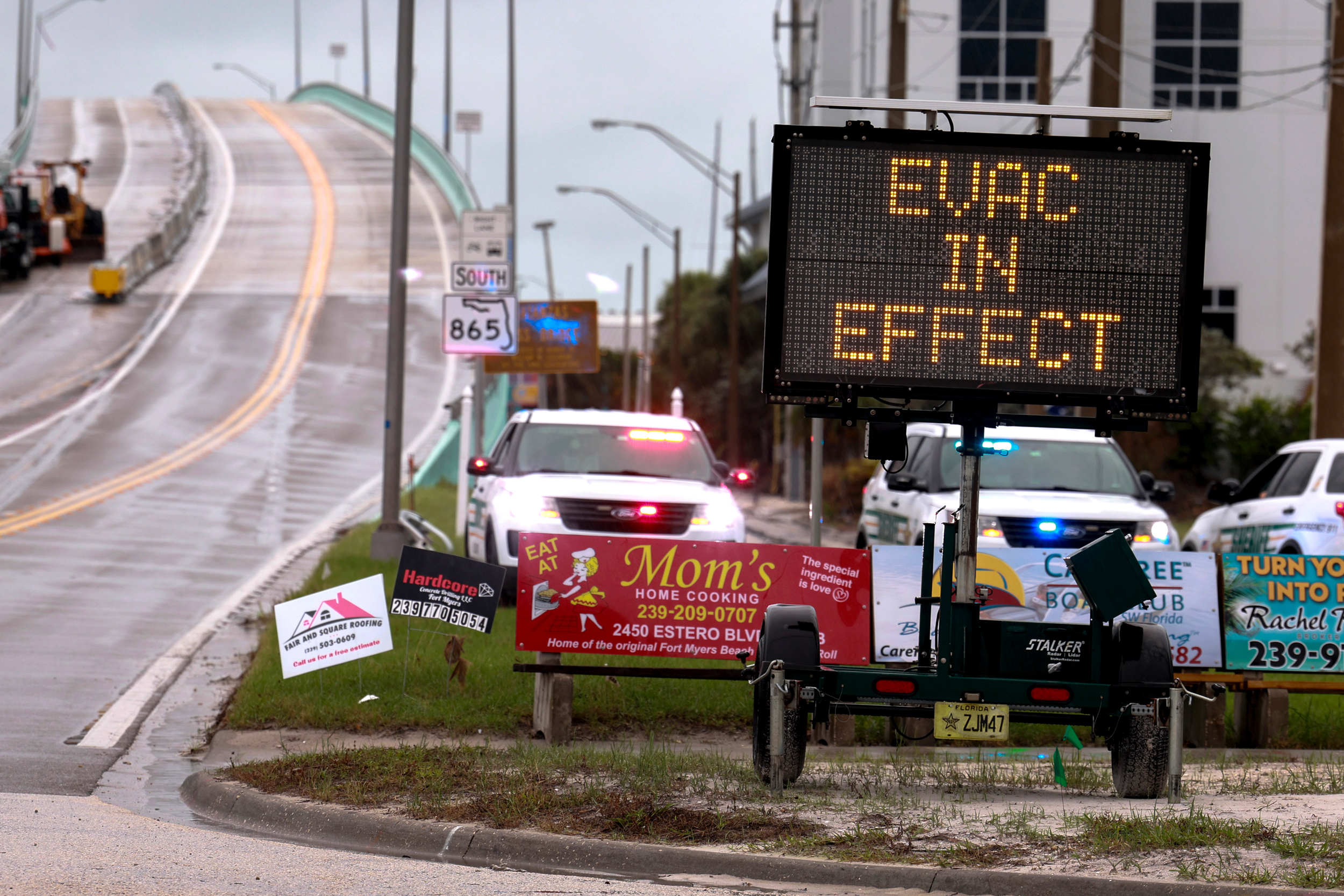Stronger Storms Like Helene Are More Likely as the Climate Warms
A new analysis from a team of scientists in the U.S. and Europe indicates that climate change increased the peak rain totals from Hurricane Helene by 10 percent.
They also found that hurricanes like Helene are becoming more likely as the climate warms. Compared to a climate from the late 19th century, a storm with Helene’s wind speed is now more than twice as likely to occur—statistically from once every 130 years to once every 53 years.
The team of scientists at the World Weather Attribution initiative have done multiple studies during the last 10 years to determine how climate change has impacted extreme weather around the world. In addition to hurricanes, their analyses have included heatwaves, floods, wildfires and droughts. For each analysis, they collaborate with local scientists who understand the nuances of the weather in their individual locations.
Explore the latest news about what’s at stake for the climate during this election season.
Hurricane Helene made landfall in the Big Bend region of Florida on Sept. 26 before sweeping inland and dumping catastrophic rainfall the following day on Georgia, eastern Tennessee, southwestern Virginia and western North Carolina. Communities in North Carolina were inundated by between 13 inches and 30 inches of rain, which triggered massive flooding. The storm killed more than 200 people.
The WWA attribution study was released Wednesday morning as another hurricane gathered immense power over the Gulf of Mexico and headed for the Florida coast. Hurricane Milton is expected to make landfall late Wednesday night somewhere between Tampa and Sarasota as a Category 3 or 4 storm, with winds of at least 125 miles per hour.
World Weather Attribution was originally formed by Friederike Otto and Geert Jan van Oldenborgh in 2015. Otto continues to lead WWA from her position at Imperial College London since van Oldenborgh died in 2020.
“Yet again, our study has shown that hurricanes will keep getting worse if humans keep burning fossil fuels and subsequently warming the planet,” Otto said in a press release.
The foundation of attribution science is analyses of weather observations and climate models. As computer resources have grown and access to data has improved, more thorough analyses can be done more quickly than a decade ago.
Using a recent generation of climate models, the WWA team will simulate the weather conditions of the modern climate thousands of times to determine how often a particular weather event occurs.
For comparative purposes, the WWA team will perform the same experiment but eliminate the human impact on the climate by removing the higher concentration of greenhouse gases from the climate models. Those gases are responsible for about 1.3 degrees Celsius of observed warming (2.3°F) since the end of the 19th century.
By comparing those two datasets and examining them against actual observations, they can estimate how much climate change impacted an extreme weather event’s intensity, probability, or both.
The team has done previous studies on hurricane rainfall, with similar results in overall scale. Rainfall totals in Hurricane Florence (2018) were 5 percent heavier than they would have been in a climate unaffected by human emissions of greenhouse gases. In Hurricane Harvey (2017), they were 15 percent heavier.
Helene fits within that range—about 10 percent.
The role of the warming climate is unmistakable. At the basic thermodynamic level, the atmosphere can evaporate 4 percent more water into a storm for every one degree Fahrenheit increase in air temperature. But work continues to better understand the scale of climate change’s impacts on hurricanes.
Michael Mann, director of the University of Pennsylvania Center for Science, Sustainability and the Media, who was not involved in the study, cautions that 10 percent value may be too low for Helene. Citing newer research examining the broader physical structure of intense hurricanes, he suggests they can physically pull in even more moisture through a process known as entrainment.
“There are a number of studies that show that there is also an important dynamical effect on top of the thermodynamic effect. Basically, stronger hurricanes entrain more moisture,” said Mann.

Otto shares that concern, noting the limitations of the current generation of climate models, which can’t replicate smaller but important features of the strongest storms. Noting that some of the observations indicate a 20 percent increase in heavy rain versus the 10 percent from the modeling study, “We should take these observations very seriously and as a warning,” she said.
Statistically, the WWA study indicates the frequency of such intense precipitation is increasing with the warming climate. The analysis suggests this type of rainfall would happen once every 116 years in the early industrial era. Now it is once every 70 years.
If the climate continues to warm to a temperature increase of 2 degrees Celsius (3.6°F) since the pre-industrial era, these rain totals would become an additional 15-25 percent more likely.
Storm Strength
WWA also used a new statistical model to simulate hurricanes in the same part of the Gulf of Mexico as Helene. Compared to an early industrial climate, a storm with Helene’s wind speed is now more than twice as likely to occur, statistically increasing in frequency from once every 130 years to once every 53 years. Similarly, the maximum wind speed of storms like Helene is now 11 percent stronger—in this case about 13 mph.
Mann offers a reminder that the power of the wind is not a one-to-one relationship with the speed. “The destructive potential of the storm scales with the power dissipation, which goes as the third power of the wind speed,” he said. “So, an 11 percent increase in wind speed corresponds to a much larger effect (roughly 33 percent increase) in destructive impact.”
Hurricane strength, and thus the maximum potential wind speed, also correlates to the warmer ocean water. Along the path of Helene in the Gulf of Mexico, the water was significantly warmer than normal. In a subsection of the analysis performed by the scientific team at Climate Central in Princeton, New Jersey, the report indicates that the warm water along the path of Helene was 200 to 500 times more likely to occur in the current climate, with the higher values in the range along the southeastern Gulf of Mexico.

Evidence is mounting to indicate that hurricanes are getting stronger more quickly. Both Helene and Milton met the formal definition of rapid intensification—an increase in maximum sustained wind speed of 35 miles per hour within 24 hours. Milton dwarfed that rate while in the Gulf of Mexico, with its winds increasing 95 miles per hour in 24 hours.
Although the precise scale of the impacts from climate change will continue to be honed and discussed among climate scientists, the consensus is clear: “I would argue that the catastrophic flooding we saw over large parts of the southeastern U.S. with Helene was indeed a major effect of human-caused warming,” said Mann.
As for the next storm, Otto recognized there are similarities between the rapid intensification of both Helene and Milton. The WWA has already been thinking about an analysis once the storm is gone.
“We will probably do a quick one. That’s the plan,” said Otto.
About This Story
Perhaps you noticed: This story, like all the news we publish, is free to read. That’s because Inside Climate News is a 501c3 nonprofit organization. We do not charge a subscription fee, lock our news behind a paywall, or clutter our website with ads. We make our news on climate and the environment freely available to you and anyone who wants it.
That’s not all. We also share our news for free with scores of other media organizations around the country. Many of them can’t afford to do environmental journalism of their own. We’ve built bureaus from coast to coast to report local stories, collaborate with local newsrooms and co-publish articles so that this vital work is shared as widely as possible.
Two of us launched ICN in 2007. Six years later we earned a Pulitzer Prize for National Reporting, and now we run the oldest and largest dedicated climate newsroom in the nation. We tell the story in all its complexity. We hold polluters accountable. We expose environmental injustice. We debunk misinformation. We scrutinize solutions and inspire action.
Donations from readers like you fund every aspect of what we do. If you don’t already, will you support our ongoing work, our reporting on the biggest crisis facing our planet, and help us reach even more readers in more places?
Please take a moment to make a tax-deductible donation. Every one of them makes a difference.
Thank you,
David Sassoon
Founder and Publisher
Vernon Loeb
Executive Editor
Share this article
- Republish
Disclaimer: The copyright of this article belongs to the original author. Reposting this article is solely for the purpose of information dissemination and does not constitute any investment advice. If there is any infringement, please contact us immediately. We will make corrections or deletions as necessary. Thank you.
Title:Stronger Storms Like Helene Are More Likely as the Climate Warms
Url:https://www.investsfocus.com










